Please Take Note: This is a review of the final game, but it might change slightly based on the success of the Kickstarter campaign. The game is being reviewed on the components and the rules provided with the understanding that “what you see is not what you might get” when the game is published. If you like what you read and want to learn more, we encourage you to visit the publisher’s website or visit the Kickstarter campaign. Now that we have all that disclaimer junk out of the way, on with the review.
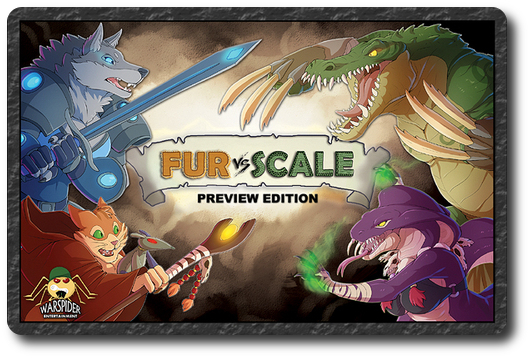
The Basics:
- For ages 8 and up (publisher suggests 13+)
- For 2 players
- Approximately 20 minutes to complete
Geek Skills:
- Counting & Math
- Logical & Critical Decision Making
- Reading
- Pattern/Color Matching
- Strategy & Tactics
- Risk vs. Reward
- Hand/Resource Management
Learning Curve:
- Child – Easy
- Adult – Easy
Theme & Narrative:
- Animal instinct meets survival instinct
Endorsements:
- Gamer Geek approved!
- Parent Geek approved!
- Child Geek approved!
Overview
British adventurer, writer and television presenter, Bear Grylls, said “The rules of survival never change, whether you’re in a desert or in an arena.” In this game, deadly warriors will clash again and again until only 1 remains standing. Each warrior represents the best of their race. To win is not only to secure victory, but to ensure the survival of their species.
Fur vs. Scale, designed by Marc Aranha and to be published by WarSpider Entertainment, will reportedly be comprised of 128 cards that represent 4 different anthropomorphic animal warriors. As this is a review of a prepublished game, I cannot comment on the component quality. The illustrations by Ramona Zukule capture the different animal warriors’ stances, jabs, punches, and a wide variety of other attacks in a way that easily communicates action and movement. Not included with the game, but necessary to play, is a pen or pencil and a piece of paper to keep track of points.
Prepare to Battle
To set up the game, first allow each player to select 1 warrior. No single warrior is better than another, but each does have unique abilities and can be played slightly differently than the others. For the most part, the initial selection will be based on personal visual preference. After playing the game a few time, players will most likely select a warrior based on tactical and strategic preferences. Our copy of the game allowed us to choose from the 4 following warriors, each unique in their own special way.
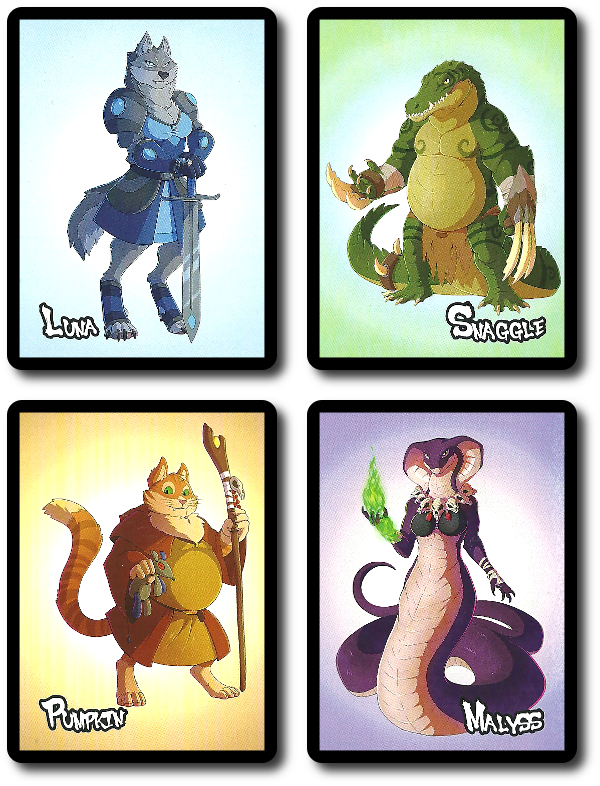
Second, give each player the 30 Move, 1 Finisher, and 1 Ability card that belongs to the player’s selected warrior. Place all other cards back in the game box.
Third, each player should place their Finisher and Ability cards to one side and then shuffle their Move cards. When done shuffling, the deck should be placed face-down to the player’s right. This is the player’s draw deck for the duration of the game. Place the Finisher and Ability cards next to it.
Fourth, each player draws 1 card from draw deck and the number values are compared. The highest number will be the first player. Reshuffle the drawn cards into the draw decks.
That’s it for game set up. Time to fight with claws, talons, and assorted weapons.
The Basics of Combat
Each warrior in the game is an accomplished combatant. The have honed their skills and can execute remarkable feats of savagery. Knowing which cards to select and which cards to leave for later is essential if the warrior is to survive. Selecting the right cards, leaving the right cards, and playing the right cards is all about timing, tactics, and strategy. The game will teach the player much, but they need not play unprepared. Using Move cards, the player will be able to attack, block, counter, and execute legendary strikes.
Attack Cards
These cards have a red “swipe” that points to the right, indicating the direction of the warrior’s attack. The number value indicates the strength of the attack.
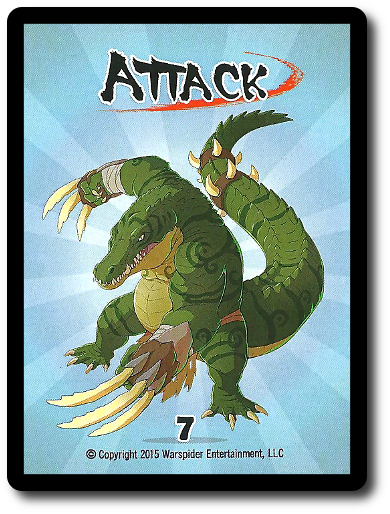
Block Cards
These cards have a blue “swipe” that points to the left, indicating the direction of the warrior’s block. The number value indicates the strength of the block.
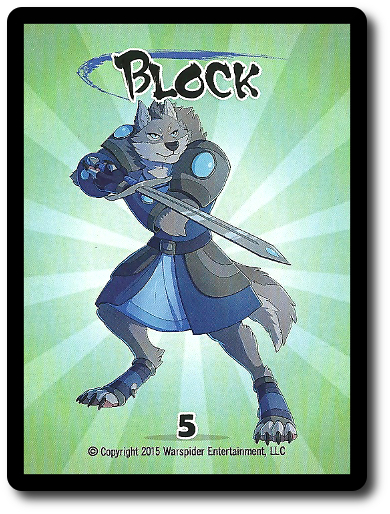
Counter Cards
These cards have both the blue and red “swipe”, indicating the warrior is blocking and attacking simultaneously. The number value indicates the strength of the counter.
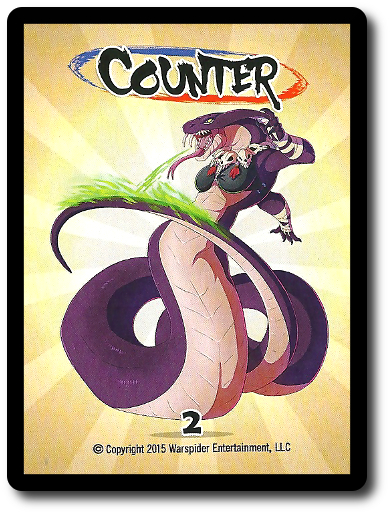
Super Card
These are flawless executions of the Attack, Block, and Counter card. Unlike the normal Attack, Block, and Counter cards that must be placed to the right-most or left-most space on the Fight map, the Super card can be placed anywhere. On the far left, on the far right, and anywhere in the middle. The row is split and room is made for the Super card, as if a mighty sword sliced it in two. But such power has limits. A player can only have 1 Super card in play per round.
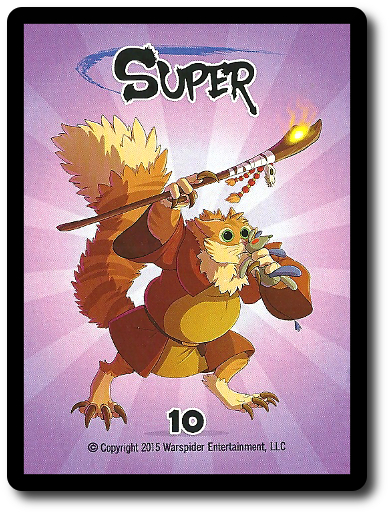
Finisher and Special Abilities Card
It’s not enough to simply execute a perfect swing of the sword. The end of a move is just as important as the start of a move. The Finisher card is played as soon as a player has successfully made a specific pattern with their Move cards. Those cards that made the Finisher possible are removed and the Finisher card takes their place. No additional cards can be added to the right of the Finisher card for the duration of the round. Any Move cards already to the right of the Finisher card are also removed. Only 1 Finisher card can be in play at a time.

In addition to the Finisher card that allows the player to permanently block off and control a portion of the game for the round, each player’s warrior has special abilities. Each special ability lists the requirements that must be met before the special ability can be used. Special abilities are, for lack of a better way of putting it, rule breakers. They also represent moments of stress and weakness that the warrior overcomes with the strength of their will. The end result is a moment of rebound, where the outcome of the battle is no longer certain.
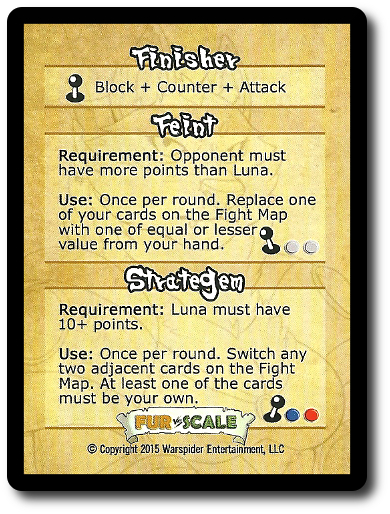
The Weak Shall Fall
Fur vs. Scale is played in rounds and turns, for a total of 4 possible rounds. A typical round is summarized here.
Step 1: Build Move List
Each player draws four cards from their draw deck and reviews them. From the drawn cards, each player will select 2 to keep and 2 to place on the bottom of the draw deck. This is done at each player’s own speed and none of the cards should be shown to opponents.
Now the process of drawing and selecting cards is repeated another 2 times. The end result will be 6 cards in each player’s hand. The cards selected are those what will be used by the player for the duration of the current round.
Step 2: Set Fight Map
Starting with the first player and continuing clockwise, each player will select 1 card from their hand and add it to the Fight Map. The Fight Map is a single row of Move cards that visually represents the battle between the warriors. It’s also where points are made, lost, and victory could be won.
The first player selects any Move card from their hand and plays it face-up to the middle of the playing area. The next player now does the same and this continues in turn order sequence. All cards added to the Fight Map are placed to the right-most or left-most end of the row in most cases. Super cards can be added anywhere in the row, thus breaking chains and disrupting patterns. Players should also take note of their warrior’s special ability and attempt to not only block, counter, and attack their foes, but build up patterns and conditions that allow them to trigger some devastating effects.
Step 3: Score the Round
After all the players are done playing their Move cards to the Fight Map, the Fight Map is locked. No additional cards can be added and no cards can be manipulated. Scoring begins with the left-most card and moves to the right.
The first condition to look for is which warrior drew first blood. The player to score a point in the Fight Map receives an additional bonus point. After that, the Fight Map is reviewed as follows.
- Attack Cards = Player gains the value of their Attack minus the Counter or Block value played by the opponent’s card to their right.
- Block Cards = Player gains the value of the Attack card played by the opponent to the left of their card minus the value of the opponent’s Counter or Attack card.
- Counter Cards = Player gains the value of both an Attack and a Block, resolving both as noted above. If the opponent to the left of the player’s card did not play an Attack or Counter card, the player’s Counter card value is reduced by half.
When determining scores, Move types stack. For example, an “Attack 2” played next to an “Attack 3” would equal “Attack 5”. However, Move cards are only stacked in this way for scoring purposes.
Combination scoring gives the player 1 additional point for every adjacent Move card on the Fight Map. For example, the stacking of the “Attack 2” and “Attack 3” will help determine points earned and won against Counters and Blocks, but the player will receive a bonus of +1 point for having both Attack cards adjacent to each other in the Fight Map. Thematically, this bonus is given to the player because they are dominating a larger portion of the battle.
Finisher cards, if played, add an additional 15 points. The cards discarded to use it are not taken into account.
Step 4: Check for Winner
After all the points are determined, they are added together and to the previous round’s score. The first player to score 60 or more points wins. If both players score 60 or more at the end of the round, the player who scored the most total points wins.
If neither player has earned 60 points, the cards played are discarded and the next player is the “first player” for the round.
If neither player has earned 60 points by the time the fourth round ends, the game is a draw.
To learn more about Fur vs. Scale, visit the publisher’s website or visit the Kickstarter campaign.
Final Word
The Child Geeks were drawn to the game, finding the illustrations of the fighting warriors to be very appealing. The game itself was easy to teach, but all the Child Geeks had trouble understanding how the game was scored. It took a few rounds of assistance before they felt comfortable enough to score on their own. As one Child Geek put it, “The game is easy to play and makes you think, but I had no idea how to score at first.” Again and again we heard from the Child Geeks how happy they were with the visual aspect of the game. It was difficult to determine if the enjoyment they were having was based on the game play or the game’s looks. According to one Child Geek, “This reminds me so much of videos games I have played. I like how every card feels like a move I would make with my controller.” The Child Geeks approved Fur vs. Scale, finding it to be a game of substance and fun, although it was difficult to decide which of the two they appreciated more.
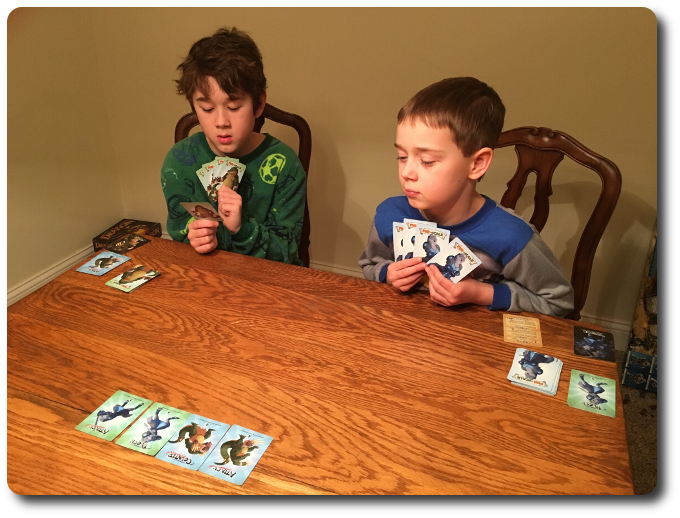
The Child Geeks learned that it was important to play the right card at the right time in the right place
The Parent Geeks didn’t have any comments about video games, but they did say a great deal about how surprisingly important card placement was in the game. According to one Parent Geek, “I guess this is what you would call strategic and tactical. I call lit deep thinking and reacting to changes. I’m really enjoying it.” The only aspect of the game that was not immediately enjoyed was the scoring. One Parent Geek said, “It takes too long, but it’s not that difficult once you learn how.” While all the Parent Geeks enjoyed the game with their Child Geeks, the number of Parent Geeks who enjoyed playing it with their peers were much fewer. As one Parent Geek put it, “I like playing this game with my son, but not so much with my wife.” Those Parent Geeks who did find a peer to battle enjoyed the game just as much as if they were playing with their offspring. All the Parent Geeks voted to approve the game.
The Gamer Geeks found the drafting of the cards and the necessity to consider two directions of possible combat to be an excellent exercise in strategy and tactics. According to one Gamer Geek, “This is a game of some serious thinking, although the level of difficulty is somewhat based on your foe. Even so, you have to really consider what cards you want, when to play them, and where. Great game.” Another Gamer Geek said, “Not a heavy game by any means, but it really engages you, moves fast, and makes you think. This would be a great filler game.” The Gamer Geeks also liked how dependent victory seemed at times on creating Finishing moves and others times not. Each round of game play was unique, played differently, had its own challenges, and presented new surprises. Again, however, we heard rumblings about scoring. One Gamer Geek said, “I like how the game is scored, as it takes into account moves made, timing, and sequence. The problem I have is that it feels like it takes longer to score the round than to play the round. All the Gamer Geeks gave it their vote of approval, finding it to be a game that entertained and challenged them in equal measure.
Fur vs. Scale is not a game you are really going to understand until you play it. After 1 round of game play, you understand everything there is to the game, but are no better a player for it. The key to Fur vs. Scale is a light mix of strategic thinking and tactical card playing. The fun part is this is done on several levels. To begin with, a player will need to decide how they want to fight the round by selecting cards. A good mix of defensive and offensive cards would seem wise, but don’t forget about special abilities. Furthermore, taking a lot of combat cards now will weaken the player’s hand later. But there is a benefit to powering your way through a round to obtain a great deal of points and demoralizing your opponent. Players have a lot to consider when drafting cards at the start of each round, as it will set the bedrock on which the player’s strategy and tactics will be built.
Second, when playing cards, a player is always either acting or reacting. The only exception is the first player’s card that sets the stage. After that, both players will be moving from one end to another of the Fight Map. The Super cards really shake things up, changing the flow and disrupting combos and patterns. The Finisher card is also a big deal and closes off a possible flow of combat making some Move cards worthless.
Third, and finally, the way cards are played is so very, very import. Setting up the combos for points at the end of the game, manipulating the Fight Map to meet special ability requirements, and staging everything for the final blow. All of this is done one card at a time and each card played must be scrutinized for its possible benefits. Short-term? Long-term? Players do not rush in this game. Cards are only slammed down when the player has carefully thought it through.
The only criticism I have about the game is how it’s scored. It’s fiddly. Cards counter other cards, reducing points, which can then be added back with combos. Counting up the final score takes longer than I wanted and more effort than I would have liked. The issue is further compounded with the difficulty of determining a player’s score during the round. A player cannot just glance at the row and quickly determine their score versus their opponents. Not because the row is constantly changing, but because it would take longer to figure out the player’s score than to simply take their turn. Time-suck aside, the scoring does make sense. When we compare it to the quickness of the game play, it feels unnaturally slow. Labored, even.
This game was a lot of fun to play and a bore to score. It excited me, tore me a part, made me shout for joy and curse up a storm. All that with only 6 cards in my hand. My whining over adding points did not subtract from the overall game play. It’s nice to know that a game that is not perfect can still greatly entertain a wide range of players. I recommend Fur vs. Scale to any gamer who likes a game with a light feel, but challenges you to think strategically and tactically from the very start to the bitter end.
This is a paid for review of the game’s final prototype. Although our time and focus was financially compensated, our words are our own. We’d need at least 10 million dollars before we started saying what other people wanted. Such is the statuesque and legendary integrity of Father Geek which cannot be bought except by those who own their own private islands and small countries.



